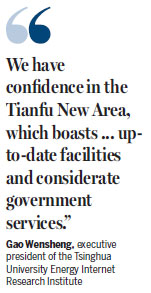Province focused on transforming research into profit
Zhai Wanming, a chair professor at Xinan Jiaotong University in Chengdu, capital of Southwest China's Sichuan province, is going through procedures to determine his research and development team's share of a special technology's intellectual property rights.
Zhai, who is also an academician of the Chinese Academy of Sciences, and his team have contributed the new technology to construction of the world's first new energy suspension railway.
Although Germany and Japan own the technology to suspension railways, their railways are powered by the grid system. The new energy railway made by his team is powered by a lithium battery pack instead of high-tension electricity. It is the world's first, he said.
Zhai's team is expected to own 70 percent of the technology and team members' ownership of the technology can be calculated into shares in a private company in Chengdu, according to a new regulation stimulating innovation made by Xinan Jiaotong University in January 2016.

To spur the enthusiasm of scientists and technicians in institutions of higher learning for innovation and entrepreneurship, Sichuan has formulated policies allowing them to turn their technology and fruits of their scientific research into shares in companies, said a source from the Sichuan provincial government information office.
In January 2016, Xinan Jiaotong University announced policies to divide ownership of technology between the university and R&D teams.
Since then, the ownership of 160 inventions made by R&D teams has been divided between the university and the teams.
As team members are employees of the university and are paid by the university, the university owns a certain percentage of the intellectual property rights of inventions. In the case of the technology of Zhai's team, the university is expected to own 30 percent of the rights.
Sichuan's policies of dividing the ownership of technology are a win-win solution as institutions of higher learning, R&D teams and companies can work together to turn new technology into market products.
Since January 2016, R&D teams at the university have used the fruits of their research to set up seven high-tech firms.
The Tianfu New Area in Sichuan, China's 11th national-level development area, has lured a great number of topnotch universities in China and other parts of the world to conduct scientific research and turn the results of that research into marketable products.
Tsinghua University established the Energy Internet Research Institute in the Tianfu New Area on March 18, 2016, following the signing of an energy cooperation agreement between the university and Sichuan a year before.
Gao Wensheng, executive president of the institute, said: "We have confidence in the Tianfu New Area, which boasts a beautiful environment, up-to-date facilities and considerate government services."
The introduction of the institute marked the Tianfu New Area's unremitting efforts in achieving innovation by cooperating with institutions of higher learning.
This year, the Tianfu New Area will adopt more policies to introduce talented personnel, stimulate the shift of scientific research results into marketable products and achieve innovation with the cooperation of institutions of higher learning, according to its decision-makers.
zhuanti@chinadaily.com.cn
|
Staff members adjust equipment at Sichuan Energy Internet Research Institute of Tsinghua University. Provided To China Daily |
(China Daily 05/23/2017 page12)
















